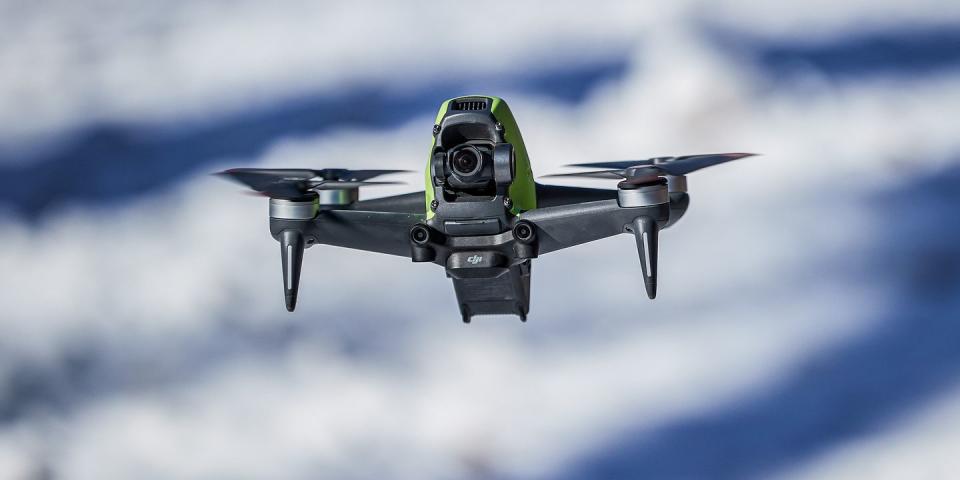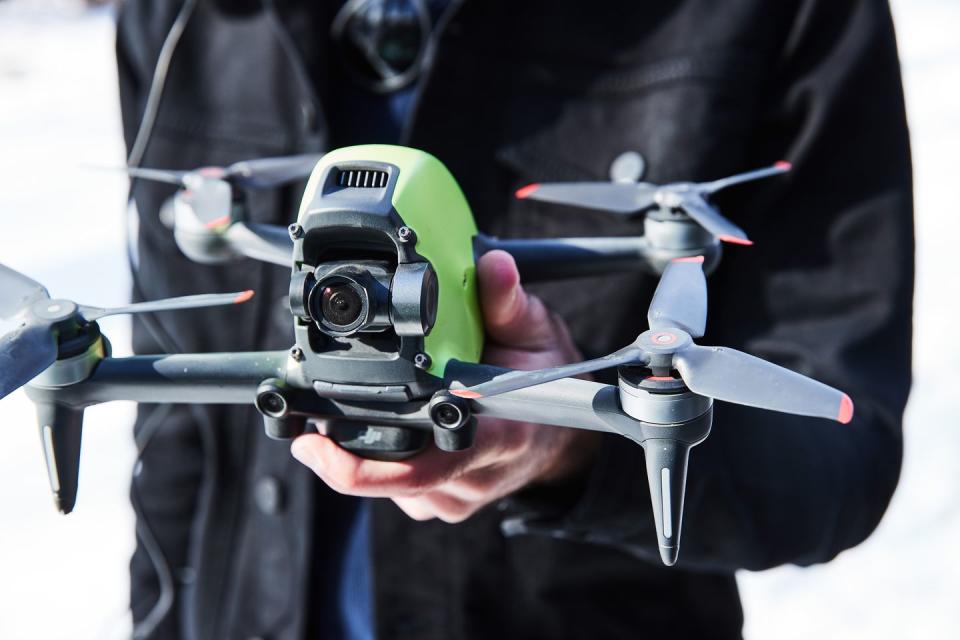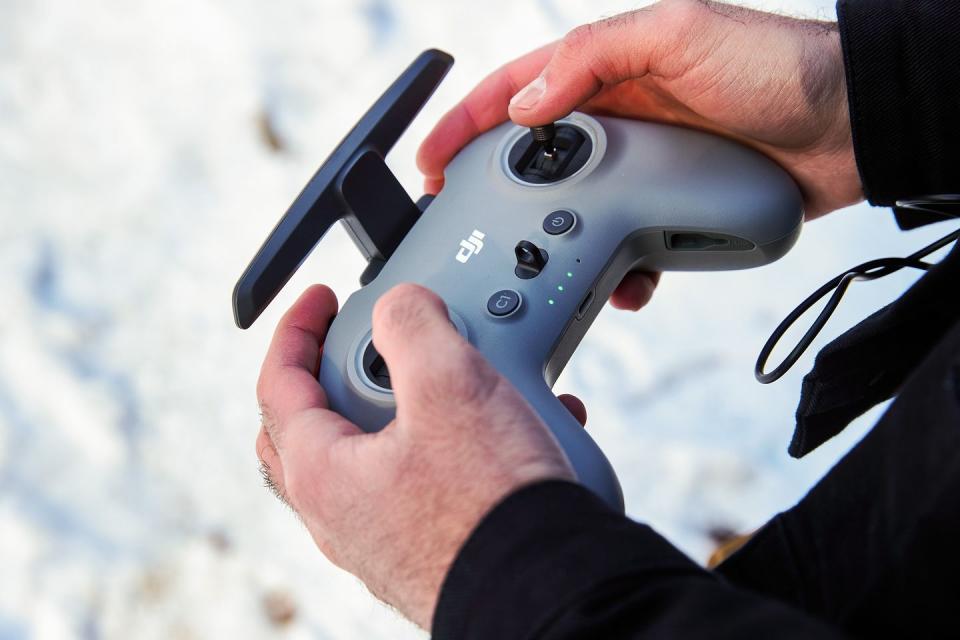DJI's FPV Drone Makes Anyone An Expert Pilot

"Hearst Magazines and Yahoo may earn commission or revenue on some items through the links below."
Most of the drones seen crashing through windows or flying away from their pilots are aerial photography drones like the DJI Phantom or DJI Mavic. While these are great entry points into the world of drone ownership, they are designed to be extremely easy to fly thanks to simplified controls that lower the level of skill needed from the operator. For those who are looking to capture more dynamic footage and experience a more acrobatic flying experience, DJI has released a dedicated FPV system complete with drone, goggles, and a controller.
While FPV drones have only just started to become mainstream, I’ve been flying and building them exclusively for five years now. Unfortunately, the learning curve to get anywhere in the hobby is quite steep—these machines take quite a bit of mental acuity to fly without crashing. That’s not to mention the mechanical side of learning how to solder and assemble the drone itself. This is why DJI’s FPV drone is such a boon, breaking through the traditional barriers to enter such a sophisticated hobby.

Quick Stats
Price: $1,299
Flight Time: 5-7 minutes
Range: 6.2 miles
Camera: 4k 60 FPS (1080P 100/120 FPS)
What Is FPV?
FPV is an acronym that stands for first-person view. These drones use a forward-facing camera that transmits its live video feed to a pair of goggles in real time. This puts the pilot in the proverbial cockpit of the drone, giving them a first-person view of what the drone sees.
When it comes to controlling the drone, FPV can offer a much more dynamic and immersive flying experience compared to what you would expect with a more consumer-level drone aimed to do aerial photography. Having said that, when controlling any drone, there are four different adjustments available to the pilot: throttle, pitch, roll, and yaw.
Throttle
The simplest control is throttle, which adjusts the altitude of the drone. While aerial photography drones will maintain their altitude without any throttle inputs, proper FPV quads generally don’t offer that luxury—giving you a much more dynamic flying experience. The former will hover in place if you let go of the controls while the latter will simply fall out of the sky.
Pitch
Next comes pitch, which controls the attitude of the drone front to back. Pitch forward, and the drone will go forward. Pitch back, and the drone will go backward. In manual mode with all of the pilot assists turned off, FPV drones allow you to do front flips and backflips.
Roll
After pitch comes roll, which allows you to move the drone left and right. However, unlike aerial photography drones that generally limit rotation to around 45-degrees on the left or right axis, FPV drones allow you to roll 360-degrees without getting in your way.
Yaw
The final way to manipulate a drone is yaw, which controls rotation. This is where aerial photography quads and FPV drones are most similar to one another. Yaw to the right and your drone will spin clockwise, yaw to the left, and the opposite will happen.
Getting Started
While I honed my skills as an FPV pilot mostly through trial and error (and tons of crashes), DJI’s drone has three different flight modes that will gradually ease you into fully manual FPV flight. This feature is especially helpful when it comes to learning how to fly FPV the “old fashioned” way as I did—a gargantuan challenge in itself.
Normal Mode
Normal mode offers the greatest amount of anti-crash assistance, something helpful for new pilots. This engages all of the collision avoidance technology onboard the drone—forward and downward vision systems as well as infrared sensors—along with GPS to stabilize the quadcopter and prevent you from crashing. If you take your hands off the controls, the drone will maintain its position in normal mode. It also limits the maximum attitude of the drone to 15 degrees and sets a speed limit of 33.5 miles per hour.
Sport Mode
Once you’ve got the hang of normal mode, the next step up is sport mode—allowing you to go faster while giving you marginally more agility on the sticks. DJI is pretty vague about explaining what this means, but it feels like it allows you more breathing room to be a bit more aggressive on the controls. However, if you use too much of any given control, the drone will still save itself by maintaining its position in the air.
Manual Mode
After reaching your maximum potential in sport mode, it's time to go into manual mode. This turns off all of the collision warning systems and gives you complete control of the drone without the training wheels that you had in sport mode. If you take your hands off the controls while this mode is active, the drone will fall out of the sky. Before you spearhead manual mode with your drone, I’d definitely recommend trying out DJI’s FPV simulator on your mobile device. Crashing in a virtual environment is much less expensive and allows you to instantly try again when things go wrong.
Flight Experience
While I'm accustomed to flying my own drones, which I've built for my own particular requirements—close-proximity, high-speed, acrobatic flights—I was impressed with the out-of-the-box performance and control of DJI's FPV drone. Following a couple of test flights, I could fine tune the feeling and sensitivity of the controls through a control interface built into the goggles. After only five or so minutes of tinkering, I had the drone dialed in roughly 95-percent where I wanted it, which is perfectly adequate for the relaxed "cinematic" style of flying that most pilots will do with this machine.

Initially, I was disappointed with the limited amount of punch that the motors offered up, which didn't cater to my aggressive flying style. Having said that, it only took me a couple of flights to realize that DJI had tuned the drone for control rather than outright performance. Its fairly large 2,000 milliamp-hour six-cell battery offered a great balance of performance, giving me around seven minutes of flight time for very tame long-range flying—if I really managed the throttle I bet I could extract up to ten minutes of flight time. While DJI never really offered up any specs on the motors, they feel very biased towards efficiency rather than performance, giving me plenty of throttle resolution. This makes it really easy to be smooth on the controls, increasing your chances of getting buttery smooth footage.
What I Liked
Starting with the pros; the digital HD video feed going to my goggles was crisp and exceptionally immersive. In my five years as an FPV pilot, I’ve only flown with analog video systems which offer far less visual fidelity and range. While I’m accustomed to flying around the limitations of less-advanced systems, the DJI feed genuinely makes me want to swap over my custom-built analog drones.

As an experienced pilot that has completed many long-range flights in the Arizona desert—sometimes traveling up to three-quarters of a mile away from myself—diving through the mountainous landscapes, I was thoroughly impressed with the long-range capabilities of DJI’s FPV drone. Along with its exceptional price-to-performance ratio, my favorite feature of all was the return to home graphic that shows up in the goggles showing you where you took off. In all of my years performing long-range flights, I’ve had to keep a mental note of the landing zone, which is really frustrating when all you want to do is enjoy the flying experience. While I was hesitant to really push the limits of range with a drone that isn’t mine, I easily matched the maximum range that I achieved with my custom-built setups.
What I Didn’t Like
One of the biggest cons with the DJI FPV system is the drone’s fragility. There’s no escaping the fact that if you crash this drone, there’s a high chance that you won’t be able to repair it. While I’m aware that DJI says there are interchangeable parts for the drone like arms and motors, I’m more worried about how delicate components like the video transmitter and flight controller would fare in a heavy crash. All that’s protecting them from hard impacts is a thin plastic shell.
Compared to the custom drones that I’ve built, which have robust carbon frames—some of which I’ve crashed into solid concrete at up to 100 miles per hour with next to no damage—I found myself very apprehensive about flying the DJI drone near obstacles of any sort. Most of the exterior is shrouded in plastic, meaning that any considerable impacts will crack or shatter these contact points. While some of my mid-flight trepidation may have come from not wanting to return DJI’s test unit in bits, there was no shortage of online reviews that revealed seemingly minor impacts can cause major damage.
Should You Buy It
If you’ve already dipped your toe into the hobby and want to expand your horizons as a pilot, I would absolutely recommend picking up DJI’s FPV drone. It’s an absolutely fantastic way to experience the thrill and excitement of FPV flight without quite as much fear and loathing about crashing and fixing your quad. If you’re completely new to drones and are willing to dish out $1,299 on a hobby you’re not entirely sure about, I’d say go for it as well—normal and sport mode are very approachable for newcomers to discover the joyous experience that is FPV flight. Should you be completely new, we’re working on a quick start guide to combat the steep learning curve associated with jumping into such an awesome hobby.
You Might Also Like
